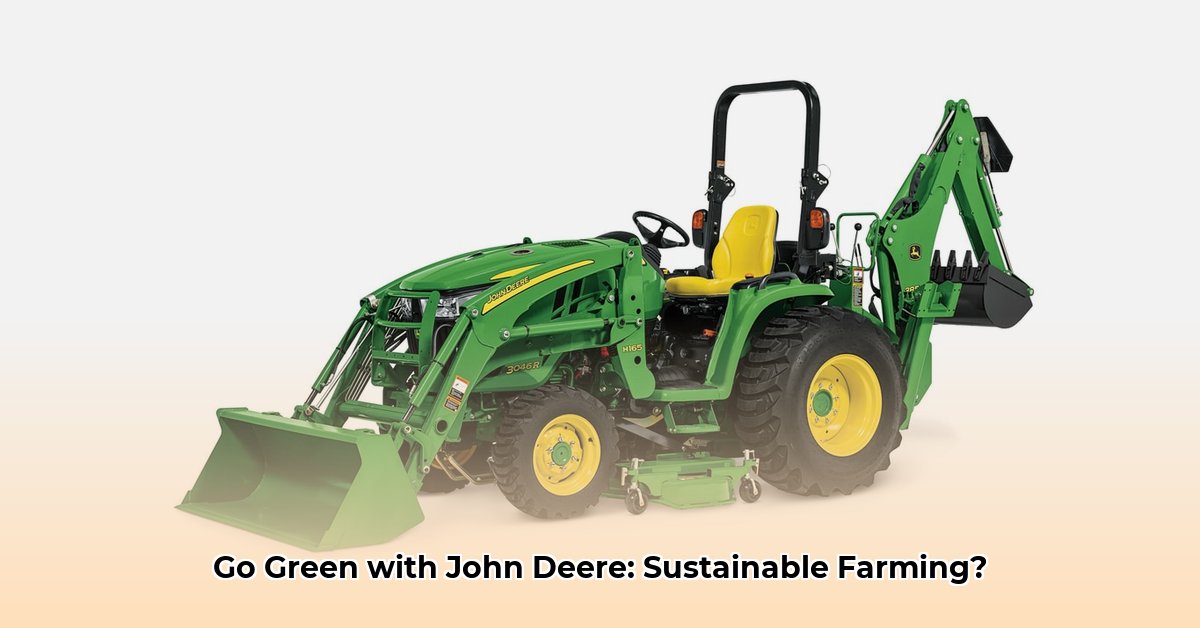
30 hp John Deere Tractor: Your Green Farming Partner
Considering sustainable farming practices? The 30-horsepower John Deere 3032E compact tractor offers a compelling solution, balancing efficiency with environmental responsibility. Its design incorporates features aimed at minimizing environmental impact and maximizing operational efficiency. But how does it stack up against other options, and what steps can be taken to truly maximize its sustainability benefits? Let's delve into the details. For more detailed specifications, check out the 30 hp tractor specs.
Fuel Efficiency: Saving Money and the Planet
The 3032E's fuel efficiency stems from its Yanmar diesel engine featuring Common Rail System (CRS) technology. This precise fuel injection system optimizes combustion, translating to lower fuel consumption per hour of operation. This directly reduces operating costs and minimizes your farm's carbon footprint. Further enhancing its eco-friendliness are the integrated Diesel Particulate Filter (DPF) and Diesel Oxidation Catalyst (DOC), which significantly reduce harmful emissions. Isn't it impressive how a more efficient engine can translate into both financial savings and environmental benefits?
Low-Maintenance Design: More Farming, Less Fixing
Downtime is detrimental to farming productivity. The 3032E's design prioritizes easy maintenance. Its accessible engine compartment and centralized fluid access points simplify routine checks and servicing. This translates to less time spent on repairs and more time dedicated to fieldwork, leading to increased efficiency and reduced waste due to unnecessary consumption of fuel and replacement parts. What practical steps can improve maintenance even further?
Thinking Beyond the Field: The Whole Picture of Sustainability
True sustainability encompasses the entire lifecycle of a product. While the 3032E excels in fuel efficiency and ease of maintenance, a comprehensive evaluation must consider the environmental impact of manufacturing, material sourcing, and end-of-life management. Further research is needed to fully quantify the tractor's total carbon footprint, including aspects like material sourcing and disposal options. John Deere's ongoing commitment to sustainable manufacturing and end-of-life recycling programs is a crucial factor in the long-term sustainability assessment of this farming asset. How can we better evaluate these aspects for a truly holistic view?
Taking Action: A Collaborative Approach to Sustainable Farming
Sustainable agriculture requires a collective effort. Here's a breakdown of actionable steps for key stakeholders:
For Farmers and Landowners:
- Short-Term: Monitor fuel consumption and maintenance costs. Select a tractor appropriately sized for your needs; avoid oversizing.
- Long-Term: Analyze total cost of ownership, including fuel, repairs, and resale value. Integrate precision farming technologies for enhanced efficiency and waste reduction.
For John Deere:
- Short-Term: Publish a comprehensive life-cycle assessment (LCA) of the 3032E's carbon footprint. Implement robust recycling programs for end-of-life tractors.
- Long-Term: Invest in cleaner engine technologies and eco-friendly materials. Explore alternative fuels like biodiesel or renewable diesel.
For Governmental Agencies:
- Short-Term: Offer financial incentives (tax breaks, subsidies) for fuel-efficient equipment and support research into sustainable farming practices.
- Long-Term: Enforce stricter emission standards and invest in infrastructure supporting sustainable farming initiatives.
For Consumers and Communities:
- Short-Term: Support local farms using sustainable practices. Purchase sustainably produced food whenever possible.
- Long-Term: Demand transparency from food producers regarding their farming methods. Advocate for sustainable agriculture within your community.
Comparing the 30 hp John Deere to the Competition: A Work in Progress
A comprehensive comparison requires more data from independent testing. The following table highlights key comparison points, but further research is necessary for complete data.
| Feature | 30 hp John Deere Tractor (3032E) | Competitor A | Competitor B |
|---|---|---|---|
| Fuel Efficiency (gal/hr) | To be determined | To be determined | To be determined |
| Emissions (g/kWh) | To be determined | To be determined | To be determined |
| Annual Maintenance Cost | To be determined | To be determined | To be determined |
How to Calculate the Total Lifecycle Carbon Footprint of John Deere 3032E Tractor
Understanding a tractor's total carbon footprint is crucial for sustainable farming decisions. The lifecycle carbon footprint encompasses emissions throughout the product's life, from manufacturing to disposal. Key stages include manufacturing, operation (fuel consumption), maintenance (part production & repair emissions), and end-of-life. Precise calculation is complex and often requires specialized software and manufacturer data, but we can outline a simplified estimation process.
Estimating the 3032E's Carbon Footprint:
- Fuel Consumption: Track fuel use over a representative period, accounting for varied operations and fuel type.
- Maintenance: Estimate emissions from replacement part production and transportation. Regular maintenance directly reduces long-term emissions.
- Manufacturing: Utilize industry averages for emission estimates, as precise data is often proprietary.
- End-of-Life: Consider scrapping, resale, or remanufacturing. Remanufacturing significantly reduces the environmental impact (John Deere's Reman program boasts 80% component reuse1).
Note: Combining these factors accurately necessitates specialized software and potentially access to manufacturer-specific data.
Practical Steps for Reducing Impact:
- Optimize Fuel Efficiency: Implement proper maintenance, use correct tire pressure, and practice efficient operating techniques.
- Invest in Biofuels: Switch to biodiesel or renewable fuels to reduce operational emissions.
- Extend Tractor Life: Regular maintenance minimizes replacement needs and extends lifespan.
- Consider Remanufacturing: Utilize John Deere's Reman program for sustainable part replacements.